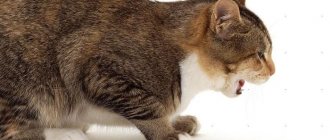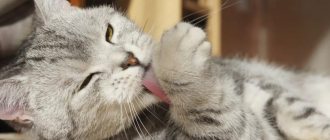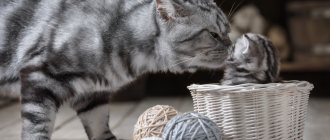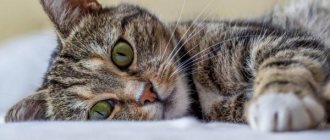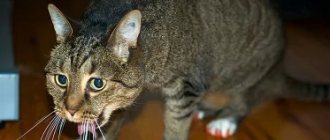Why do hairballs form?
Scientifically, the wool balls or sausages that form in the stomach and intestines of a cat are called trichobezoar (“hair tumor”) - a mixture of hairs, food debris and gastric mucus.
Sometimes a cat vomits hair
The reason for their formation is that representatives of the cat family carefully care for their fur using their tongue. The fact is that it is covered with small hook-shaped growths, which, when licked, pick up hairs. Next, individual hairs pass into the animal’s stomach, where they accumulate in the form of balls or sausages and are periodically released with vomit.
Small accumulations pass through the digestive tract further into the duodenum and small intestine, then are excreted in the feces. A large lump can get stuck in the intestines and cause constipation or obstruction, stricture and esophagitis.
Hairballs from a cat's stomach
Natural causes
If the ingested hairs are not excreted, the cat will periodically regurgitate the hair to remove these non-food items from the stomach. Because the wool masses pass through a narrow esophagus, they look like sausages. In this case, vomiting is accompanied by coughing sounds.
In long-haired breeds (Persians, Maine Coons and others), this natural cause of the formation of trichobezoars is most common - they can spend more than 10% of their time licking their coat.
Cats swallow fur when licking themselves.
Additional Information! Kittens practically never have such lumps in their vomit, because they are licked by the mother cat, but as they grow, vomiting of swallowed fur in a young cat becomes more and more common.
The cause of vomiting itself can also be grass specially eaten by the animal for cleansing.
Dangerous reasons
If your cat vomits hair quite often, you need to visit a veterinary clinic so as not to miss the onset of a serious illness in your pet.
So, some dangerous reasons why a cat pulls out hairballs and swallows them are:
- Flea infestation. At the same time, the volume of ingested fur sharply increases as a result of itching from bites.
- Allergic dermatitis and other skin problems, the symptoms of which are unbearable itching.
- Being in stressful situations, when the animal licks itself to calm itself, as well as as a result of increased excitability of the sympathetic nerves.
- Chronic diseases of the gastrointestinal tract due to an inappropriate diet, accompanied by impaired motility of the upper digestive tract.
- Diabetes, kidney and thyroid diseases, intestinal inflammation.
What happens if a hairball gets into a cat's intestines?
If the trichobezoar is small and has advanced into the intestine, then with good peristalsis it will be released naturally, with feces, without any unpleasant consequences.
If the hairball is sufficiently dense and large, then blockage of the intestinal lumen may occur, which is clinically expressed as constipation, abdominal pain, lethargy and apathy. The cat experiences discomfort and stops eating and playing.
Due to blockage, the intestinal walls become inflamed, and blood may appear when attempting to defecate or in small amounts of stool.
In such situations, it is necessary to give the cat at least 20 ml of Vaseline oil, and if the animal does not go “big” within 24 hours, you need to go to the veterinary clinic. The doctor will conduct an examination, determine the location of the problem and prescribe appropriate treatment.
In rare cases, surgical removal of conglomerate from wool is prescribed.
Important! A cat with a complete blockage of the intestinal lumen will die in a few days without veterinary care, so you can’t hesitate!
Symptoms of having fur in the stomach
Why does a cat vomit after dry food?
To avoid further problems with the gastrointestinal tract, the owner of the animal must be able to recognize the situation when excess hairy mass accumulates in the pet’s stomach and it is necessary to take action. So, the warning signs are:
- The animal refuses to eat or eats less than the usual portion because the stomach is already filled with hairballs. The cat will constantly stomp around the bowl, as if not knowing what to do, because the level of glucose in the blood is low from hunger, but the stomach is full.
- The fur becomes dull and no longer shines, which is caused by the animal not receiving the necessary nutrients.
- Periodic coughing and urge to vomit. The larger the resulting lump, the more difficult it is for the animal to get rid of it when the cat vomits hair because the gastric sphincter does not open wide enough.
- The presence of stuck (or worse, ingrown into the gums) hairs on the cat’s teeth. Having discovered them, it is necessary to take measures to clear the digestive tract of trichobezoars.
- The cat becomes lethargic and apathetic, constantly sleeps and does not play, as usual, avoids communication.
- Constipation that lasts more than one day. This situation can arise as a result of the stomach being completely filled with swallowed wool and often leads to general intoxication of the animal’s body.
- The cat is vomiting in masses mixed with blood.
Physiology
All cats lick themselves very often, in the process of which a large amount of hair is swallowed, which the pet is simply not able to digest.
That is why they have physiological reflexes that allow them to promptly get rid of the hair accumulated in the body. The cat's gastrointestinal tract is designed in such a way that fur accumulates in the stomach, but practically does not enter the intestines, with the exception of a small amount. At a certain moment, the body cleanses itself, the gag reflex is triggered, and the cat regurgitates the accumulated mass in compacted lumps or “sausages” of an oblong shape.
Normally, this happens 2-3 times within 3-4 months, but the data is relative, since the length and thickness of the coat, the molting period and the general condition of the animal are of great importance. If vomiting occurs more often or lasts for several days in a row and even several times, this indicates a pathology. Bezoars (lumps that form) may not come out naturally and can block the gastrointestinal tract.
First aid
The cat sheds a lot: what to do in such situations
If a cat has vomited hair once or twice, there is nothing in the vomit except trichobezoars and grass; no help or special treatment is required for the pet. Is it possible to limit food consumption for a while so that the animal’s stomach has a little rest from vomiting.
If hair vomiting occurs frequently, you should take your cat to the veterinarian.
If your cat has repeatedly vomited hair, you should evaluate the presence of other alarming symptoms in your pet:
- depressed state;
- refusal of food and communication;
- constant long sleep;
- frequent diarrhea and urination (urine is deep yellow);
- increased body temperature;
- discharge from the eyes or nose;
- sneezing and thirst.
In the presence of such phenomena, vomiting and nausea are a symptom of life-threatening diseases - it is necessary to urgently take the animal to the veterinarian. He will prescribe fluid and antiemetic therapy, and perhaps run some tests to determine exactly why your cat is vomiting fur too often or excessively.
Important! If the cat is over 7 years old, even with infrequent vomiting of hairballs, you should undergo a preventive examination to check for the onset of chronic diseases.
The cat licks its fur until bald patches appear
Cornell Feline Health Center. Cats That Lick Too Much (March 29, 2006)
Why does a cat lick itself?
Licking fur is natural for a cat. All cats lick their fur
, although they differ from each other in cleanliness.
Obviously, a cat licks itself to be clean. Licking also smoothes the coat, improving its thermal insulation properties. When licking, cooling also occurs - energy is expended on the evaporation of saliva that reaches the skin, and body temperature decreases.
A cat licks its lips when you pet it. She does this in order to return her own scent to the place where the scent of your hand remains. The absence of foreign odors is important for the cat’s peace of mind. The world of cats is a world of smells, unlike the world of people, which is based on vision. In addition, the cat remembers your taste in this way. She may lick your hand to express her friendship.
Have you noticed that the cat licks its fur in an unusual way?
Sometimes the normal process of grooming becomes obsessive. This excessive licking is a signal that there is a problem.
Licking that causes excessive hairball regurgitation or even balding skin is abnormal. The skin is exposed to sunburn, hypothermia and other adverse environmental influences. Intact skin is resistant to infection.
If a cat licks its fur to such an extent that it breaks the integrity of the skin with its rough tongue, infection may occur in these places. The infection, in turn, increases the intensity of licking. Thus, a vicious circle of “infection-licking” is formed. It can be broken only by identifying and eliminating the original cause.
The owner can check for the presence of parasites (fleas, lice, etc.) in the cat's fur; in addition, consultation with a veterinarian is necessary.
If your cat licks its fur too often or for too long, do not ignore this fact. A cat can lick itself to such an extent that there is no hair left on the skin.
Usually, owners notice that the cat licks its fur too often when bald spots appear on the stomach and other easily accessible places on the body. One sign of excessive licking is frequent regurgitation of hairballs.
This means it's time to stop observing and start taking action. What to do if you decide that your cat pays more attention to licking its fur than necessary?
According to Doctor of Veterinary Medicine (DVM) Pamela Perry of Cornell University's Animal Behavior Clinic, the average cat spends 30 to 50 percent of its grooming time grooming. This is quite a lot, so owners do not pay attention to the problem until they notice significant hair loss or even skin damage.
One reason may be an allergic reaction to food. For example, dry food may contain plants that cats do not naturally eat. Consult with experts and choose food suitable for your cat.
Itching and parasites
The cat licks areas of the body where it is itchy or painful. Licking in the anal area can be caused by constipation. Sick areas are licked more “targeted” than itchy areas. In case of itching, the licking area exceeds the size of the itchy area.
The appearance of bald patches provides clues to the cause of excessive licking of fur. These reasons can be different - from the presence of parasites, to neurological conditions, often several at the same time.
For example, compulsive tail licking may indicate the presence of fleas, while cats with pollen or food allergies are more likely to lick the back, belly, and other parts of the body.
Skin wounds
Cats lick scratches and other skin lesions. This is a normal process that cleanses the wound. In nature, a cat has no other way to take care of itself. However, this may be undesirable when the wound is treated with some kind of ointment or a suture is applied. To prevent unnecessary licking, you should limit your cat's access to the affected area.
Cats really don’t like closed doors, where they used to go freely. The cat is worried, not knowing what is happening in the closed (its!) territory.
Additionally, while cats can get by with a small living space, it shouldn't be too small. Perhaps any of us would begin to tear our hair out, being locked in an apartment 24 x 7 for years.
We consult with family members when making any decisions. And although we cannot consult with a cat, we are quite capable of taking its interests into account.
Stress-induced licking
Excessive licking is not always associated with a cat's physical health. Its cause may also have a psychological basis. Cats like their lives to be predictable and orderly, so unexpected changes can be stressful, says Dr. Perry. Reconstruction of the apartment, the appearance or disappearance of other animals, and sometimes even a change in regime cause anxiety in cats.
It happens that people try to force a cat to live by their own rules and do what they see fit. Such tricks do not work with cats - she is a free animal (conditionally domestic), she cannot be defeated, you can only come to an agreement. It is necessary to take into account her interests, creating as many opportunities for the cat as possible to satisfy her natural needs.
Licking in such cases is considered “replacement behavior” (people in such cases behave similarly, for example, biting their nails) - it calms the cat, but at the same time can become habitual if the source of anxiety is not noticed and eliminated in time.
If all medical problems are resolved, then treatment for excessive licking as a result of some form of stress in the cat's life is necessary, says Dr. Perry. If possible, changes should occur gradually, while maintaining elements of the environment familiar to the cat.
For example, when moving, you need to take the cat house with you. Provide elevated platforms that cats love - they make the cat feel safe and are perceived as possible escape routes.
Help your cat show its hunting instincts by playing with it for just 10-15 minutes a day. Most cats love to be played with. If a cat gets what it likes, be it a favorite toy or a hug from its owner, then the stressful state goes away easier and faster.
The stress may be so severe that the veterinarian may prescribe medication, continues Dr. Perry.
In addition, licking gives cats some pleasure. Thus, excessive licking can become a habit that continues after the cause is identified and addressed. Typically, a cat's fur licking returns to normal (on its own or after assistance) within a month.
With both physiological and mental causes of licking problems, resolving them takes time and patience. With proper attention and care, the cat's fur is restored and life returns to normal.
Additional Information
Source: https://koshsps.ru/vyliz.php
Treatment
The cat hides in dark places - the main reasons and what the owner should do
If the presence of symptoms indicates the formation of hairballs in the cat's gastric tract, and the veterinarian confirms this, it is necessary to rid the animal of them and take measures to prevent their further formation using various veterinary drugs.
Note! In short-haired breeds, dead hairs can also accumulate in the stomach, only, due to their rigidity, they stick together into prickly lumps, which sometimes stick to the walls of the mucous membrane and provoke repeated vomiting.
Drug treatment
Before starting to use medications, it is necessary to find out the cause of vomiting, this will help to more accurately select treatment and dosage of drugs. In general, to empty the stomach, metoclopramide is used at a dose of 0.2-0.4 mg per kilogram of the cat’s weight, ranitidine - 5 mg/kg, cerucal or even no-shpa at a dosage of 0.1 mg per 1 kilogram of the animal’s weight. However, long-term medication is not required.
Also a popular medication for the treatment of hairy stomach lumps is malt paste. It is squeezed directly into food, and cats eat it with pleasure.
Malt paste is used to treat hairballs in the stomach
Consuming the paste helps remove ingested villi naturally along with the animal’s feces and further prevents lump formation in the stomach and intestines. If you use it regularly, even long-haired cat breeds will stop vomiting hair.
Special food
Manufacturers of cat food have made sure that tailed fluffies do not have such situations when a cat or cat vomits hair - for this they produce special food (for example, “Cat Show Hairball Control”, “Proplan” - a line for domestic cats), which have contains additives that prevent swallowed wool from rolling into lumps and getting stuck in the stomach or intestines. It is enough to feed your pets a couple of kilograms of this food for several months.
If your cat frequently burps clumps of ingested hair, veterinarians also recommend following a grain-free diet in its diet, since these animals are carnivores, their natural food is protein, and grain products contain many carbohydrates, which change the microflora of the gastrointestinal tract so much that its mobility is reduced. and the swallowed wool ceases to come out of it.
ethnoscience
Traditional medicine recipes in this matter are based on the instinctive ability of cats to determine when it is time for them to cleanse their stomachs of “garbage.” Thus, many pet stores sell already sprouted grass in containers. Cats eat it with great pleasure because it helps digestion and gets rid of stomach troubles.
Cats eat grass to cleanse their stomachs of fur.
For reference: young shoots of wheatgrass, which often grows as a weed in yards and even ends up in flower pots, are especially helpful.
If urgent help is required in a situation where the cat often regurgitates fur, and there are bile impurities in it, decoctions of flaxseed or chamomile, as well as a further diet including chamomile decoction and plenty of water, will help.
The total recommended daily consumption of medicinal decoctions is from 1 to 3 tablespoons, determined by the weight of the animal and the severity of its condition.
Treatment and prevention of hair vomiting in cats
Common methods of treating cats with hair vomiting:
- Internal administration of petroleum jelly. It has a laxative effect by softening the intestinal contents and stimulating the motility of the digestive tract, as a result of which the cat has bowel movements faster and easier. In this case, the drug is not absorbed (does not affect the functioning of the liver and pancreas), but leaves the body along with the animal’s feces. A single dose of the drug equal to 10 ml (forcefully injected into the mouth from a syringe without a needle) is considered prophylactic. For frequent constipation, a cat can be given up to 20 ml of oil for no more than 5 days. Next, you should replace the product with human drugs "Duphalac" (inside), microenema "Microlax" (in the rectum) or Lactusan (inside).
- Endoscopic hairball removal. This is a non-surgical method, it is used in veterinary clinics that are equipped with modern flexible endoscopes. Under ultrasound control, the doctor determines the location where the hair conglomerate is located. The cat is put under anesthesia, then the doctor uses a special device through the oral cavity to remove hair from the gastrointestinal tract.
- Abdominal surgery: the trichobezoar is surgically removed. Doctors often have to remove part of the intestine due to severe inflammation or tissue death.
As preventative measures to prevent vomiting with hair, it is optimal to use:
- special malt pastes for cats and ferrets;
- offer cats fresh grass (sprouted wheat or oats);
- periodically introduce a few drops of vegetable or fish oil into the animal’s diet;
- with natural feeding, increase the proportion of vegetables or dry fiber (purchased in pharmacies);
- Brush the cat during periods of heavy shedding and bathe it once (every few months).
Combing
Brushing is an incredibly pleasant and beneficial procedure for cats. It is recommended to carry it out from a young age in order to accustom the animal to a comb. Upon completion of the process, the cat should be treated to its favorite treat (this will consolidate the positive result).
Suitable accessories for combing are: combs without balls on the teeth (this prevents healthy hair from being torn out), rubber gloves (with a massage effect), cat slickers, furminators (unique trimmers that comb out the undercoat).
How to properly brush a cat:
- pet the pet;
- lay the cat on its side;
- carry out several combing movements in the direction of hair growth (from head to tail);
- turn the cat over on the other side and repeat;
- put the animal on its paws or sit it on the owner’s lap, comb the back, head, neck, tail;
- turn the cat over on its back and brush its belly.
Regular brushing (once a week) reduces the amount of hair ingested and therefore reduces the likelihood of vomiting.
Proper diet and feeding regimen for cats to prevent hair vomiting
A well-designed cat diet is half the success in the fight and prevention of various gastrointestinal diseases, including frequent vomiting. Today, the pet supply market is replete with a wide range of complete cat foods of various classes, including special diets labeled “hair removal.”
A special feature of the formulation of wool-breeding feeds is the increased content of plant fiber, prebiotics, and oils. Some brands add ingredients that can reduce the length of time animals shed. It is these foods that are best purchased for cats with a tendency to frequently vomit hair.
If the cat is on natural feeding or table food, then meat fibers and fiber from vegetables help move hair through the intestines.
A few more tips to prevent hair vomiting in your cat:
- you need to select food with small croquettes - the larger the granules, the longer the food will move through the gastrointestinal tract;
- You should not pour a full bowl of dry food to a hungry cat, it is better to do this often and in small portions (if the cat overeats, it may vomit some of the food immediately after swallowing);
- If necessary, give the cat Vaseline oil; it must be administered on an empty stomach so as not to reduce the absorption of fat-soluble vitamins from food.
Fur removers and sprouted herbs against fur vomiting
Caring owners know that when a cat begins to vomit hair, they need to go to the pet store for malt paste. A tasty and aromatic supplement to the diet of cats contains up to 40% fat and malt extract.
These components gently separate and remove clumps of swallowed hair, undigested food particles, and also stimulate the growth of normal intestinal microflora. Malt paste is not only tasty, but also healthy, as it contains vitamins and minerals.
How to feed malt paste:
- spread the paste on the front paw (the cat will definitely wash itself and lick off the additive);
- apply a little paste to your nose;
- squeeze on top of the food;
- straight from the tube.
Important! The dosage and frequency of use depend on the degree of fluffiness of the cat and the stage of shedding. This information is best found on the packaging.
Another way to help your pet get rid of hair vomiting is to leave a bunch of green grass (sprouted oats, wheat, corn) next to the bowl.
Cats instinctively eat grass to cleanse their stomach, as its coarse fibers irritate the stomach walls and trigger the gag reflex.
For hundreds of years, people have valued and loved cats for their intelligence, beauty, loyalty and grace. New products and drugs appear regularly to preserve the active longevity of pets.
Caring owners need to understand a little about the existing methods available and know the main cat problems. The veterinarian will help with the rest.
Prevention
Despite the fact that vomiting hair is almost a physiological inevitability for cats, loving owners should do everything possible to avoid it.
The first thing you need to do regularly (especially for medium- and long-haired breeds) is to thoroughly comb your pet. Cleaning the “fur coat” helps rid the animal of most of the dead hairs, and he does not have to independently pull them out with his tongue and swallow them. The less such “garbage” gets into the cat’s stomach, the less often she will have the urge to vomit with trichobezoirs.
To prevent ingestion of fur, the cat must be combed
Don’t forget about the availability of fresh grass for your cat; it’s best to place a pot of sprouts right next to the food bowl.
The cat’s body’s protective reaction is to regurgitate hairballs, which it has to tear out and swallow when licking. The situation may frighten inexperienced owners, but it is absolutely physiological. It should be remembered that repeated vomiting of fur can be a symptom of serious health problems that need to be addressed with your veterinarian. One-time cases of hair vomiting can be dealt with by regularly brushing the cat, giving it “anti-hair” pastes, as well as correctly forming the diet, enriching it with fresh grass.
Preventive measures
To prevent the problem, you should follow simple preventive measures. The basic rule is to brush your pet regularly. For long-haired breeds, it is recommended to carry out the procedure at least once a day, especially during the molting period. It is better to get used to combing from childhood - the pet will get used to it and will be calm about the ritual.
It is also recommended to plant a special grass, the seeds of which can be purchased at a pet store or veterinary pharmacy. Regular consumption of greens helps remove hair from the intestines, normalize the functioning of the digestive tract, and replenish the lack of vitamins or minerals in the body. Veterinarians also recommend introducing a special food into the diet, the formula of which contains elements that effectively cleanse the digestive organs.
Be sure to provide your cat with access to clean water. Fresh liquid activates the digestive processes and prevents the formation of large, dense hairballs. Drinking water regularly will also help prevent intestinal blockages or stomach problems.
If a pet regularly regurgitates, owners are advised to carefully monitor the pet for several days - if there are no additional symptoms of disorders, there is no particular reason to panic. If your cat spits up hair every other day or even more often, it is better not to neglect the help of a veterinarian.
How to treat an animal?
There are several important tips that should be followed in order to bring the animal into a normal state and stop the urge to vomit.
It must be remembered that with frequent vomiting, the cat’s body becomes dehydrated. It is especially bad if, along with vomiting, the animal develops diarrhea - in such a situation, it loses fluid much faster. In such a situation, you should remove water and any food from your pet so that it does not irritate its stomach even more. Then you should remove the intoxication. In this case, everything depends on the appearance of the discharge and the reasons that provoked this condition.
For example, if we are talking about banal overeating, then you need to take a break from eating for at least five to eight hours. At the same time, water must continue to be given to the animal, albeit in small quantities. The first sign that your cat is feeling better is the appearance of an appetite. During this period, you should be especially careful; you do not need to immediately pour a large amount of food into the animal, try to slowly accustom it to gradual food intake. This will help restore digestive processes in the animal’s body and not harm it even more.
If your cat is vomiting, you should feed her small portions.
You need to feed your pet dietary food that will help its body recover properly - the family pet will begin to recover and will no longer scare household members with its condition. It should be remembered that it is best to give him small portions, but often.
This is the first piece of advice on what to do if a cat vomits. Next, the owner must follow the recommendations given by the veterinarian, and this must be done accurately and without delay. Only in this case will it be possible to restore the health of your pet.
It is very common for a cat to vomit for several days in a row, so it is important to know what to do when a cat vomits for a second day. It is necessary to clarify what exactly needs to be used to treat a particular disease.
If your cat is vomiting, mint decoction will come to the rescue.
First of all, you should follow a gentle diet. The list of permitted products includes:
- decoction of rice grains;
- lean meats, chicken is best;
- A food with medicinal properties that is specially formulated for cats suffering from vomiting and other similar symptoms.
After your pet has been on a diet for a while, you can gradually switch to a normal diet. However, portions should still be small and meals should be taken frequently.
You can also resort to using folk remedies. These can be decoctions of chamomile, flax or mint.
They are given to the animal three times a day, several tablespoons. The one-time volume of decoction used depends on the weight of the cat itself.
If we talk about veterinary drugs, it is possible to use intramuscular injections.
If the cat is sick, it is advisable to feed it lean meat
If a cat is vomiting hair, then there is no need for strong remedies; the main thing to do in such a situation is to rinse the animal’s stomach and reduce the degree of irritation of this internal organ.
If your cat is vomiting and diarrhea, then the first thing to do is call a doctor. Self-medication can harm the animal.
Message to this thread
Forum → Pets: new topics
| Tray filler | / 22 | 1 day ago ← | MarishkaKa | |
| To castrate or not to castrate—that is the question. 2 3 | 53 | / 39196 | 10 days ago ← | Albino |
| I want to get a kitten 1 2 | 32 | / 4943 | 1 month ago ← | Student |
| My cat is vomiting fur, what should I do? 3 4 | 79 | / 63305 | 3 months ago ← | sasha5060 |
| Pet supplies for cats | / 143 | 3 months ago ← | MarishkaKa | |
| New veterinary clinic in Troitsk | 8 | / 8916 | 4 months ago ← | KolaNikola12 |
| Kill odor and disinfect – LYUBISAN | 7 | / 2658 | 4 months ago ← | Ada |
| animal care/pet hotel | 1 | / 291 | 4 months ago ← | vavva |
| Ultrasonic teeth cleaning for small breed dogs. | / 214 | 5 months ago ← | nun_pigeon | |
| How to choose a dog? 3 4 | 65 | / 29358 | 5 months ago ← | Marica |
| Where can I walk my dogs? 12 | 35 | / 15330 | 5 months ago ← | KaterinaS |
| Veterinary clinic Cat Behemoth, Voskresenskoye village | 1 | / 9234 | 6 months ago ← | KolaNikola12 |
| the dog is sick | 11 | / 5020 | 6 months ago ← | Oleg26 |
| Sphynx kittens for sale | 10 | / 3754 | 7 months ago ← | Thada |
| the cat fell from the 9th floor | 7 | / 2930 | 7 months ago ← | Thada |
| Pet supplies for cats | / 169 | 7 months ago ← | MarishkaKa | |
| tell | 11 | / 1329 | 7 months ago ← | graft |
| How do you remove ticks? 12 | 28 | / 13553 | 8 months ago ← | Zadira |
| Veterinary clinic | 4 | / 2134 | 8 months ago ← | Karishka Marishka |
| House for a kitten | 14 | / 1919 | 8 months ago ← | Ankeros |
How to identify the cause of vomiting?
First of all, you need to control what your pet eats. If he becomes ill from a particular type of food, then it is better to replace it with another. You should worry about all this in advance. For example, it is best to buy some food and give it to your pet to try. If the cat feels normal after using it, then you can safely switch to it. Well, if the animal has any stomach problems, then it is better to refuse this type of food and try another.
Also, you should immediately contact a veterinarian if your pet’s vomiting repeats after every meal, especially if it gets worse after eating. This may be a sign of the development of kidney or liver disease, and vomiting may also be a sign of the development of an infectious disease in your pet.
If your cat is vomiting, contact your veterinarian.
If vomiting occurs frequently, you should definitely check your animal for parasites and diseases such as:
- the presence of an inflammatory focus in the uterus;
- the presence of inflammation in the intestines;
- the presence of problems in the functioning of other internal organs.
It is worth remembering that a timely trip to the veterinarian will help avoid the development of more serious diseases.
It is equally important to pay attention to the composition of your cat’s vomit. For example, if there are impurities of blood or bile, then you should immediately contact a veterinarian. This indicates the presence of a severe functional disorder in the animal.
Every cat owner must know what to do when an animal vomits food.
It is important to pay attention to the composition of your cat's vomit.
As you know, a cat can vomit with a liquid having a different composition. Different compositions of the masses ejected by cats during the process of vomiting can signal the presence of a specific disease in the cat. For example, if the mass ejected during vomiting has the appearance of white foam, this may indicate that at the time of vomiting the cat’s stomach and esophagus were empty.
If during the period of vomiting the animal secretes a yellow liquid, this indicates that the pet has a dysfunction of the liver and gall bladder in the body, because it is known that liver secretions should not be present in the stomach cavity. Such signs may appear when repeated vomiting occurs when the stomach and esophagus are empty.
The owner must pay attention to the health status of his animal if the pet begins to vomit bile
Based on the foregoing, it becomes clear that every owner should have an idea of what to do when his cat vomits bile, since this type of vomiting is fraught with serious consequences for the animal’s body.
Another equally difficult problem arises when a cat begins to vomit blood. In this case, you should clearly know and understand what needs to be done in a given situation. A pet may vomit a mixture of two different types, namely:
- mass with scarlet bloody impurities;
- a dark mass that resembles coffee grounds.
The presence of scarlet blood may mean that the animal has injuries in the nasopharynx, esophagus, or ordinary wounds in the mouth, so each owner, first of all, needs to examine the pet’s oral cavity and rule out the presence of injuries, as well as various foreign objects.
You need to examine your pet's mouth if he has vomited.
When the masses with which an animal vomits are dark brown in color, this may signal that certain negative processes begin in the gastrointestinal tract, resulting in gastric bleeding, and under the influence of gastric juice the blood simply changes its color. You should know that gastric bleeding begins as a result of foreign bodies entering the stomach, and the presence of this type of vomiting may indicate gastritis or a tumor.
Based on this, every owner should know what to do when a cat vomits frequently or when it vomits a mixture containing blood.
Naturally, every owner is concerned about the question of what to do if a cat vomits. In such a situation, it all depends on what exactly the animal is vomiting with and how often it happens.
In any case, it is best to contact a qualified specialist who will conduct a full examination and prescribe the correct treatment regimen.
Your pet must be periodically treated with flea repellent.
Also, you should take some preventive measures that will help minimize the possibility of developing diseases accompanied by vomiting.
First of all, you need to adhere to a schedule of regular examinations with a doctor; you should not neglect timely vaccination.
The pet must be periodically treated with flea treatment to prevent the possibility of worms.
To the question of what to do if a cat vomits hair, the answer is very simple - the formation of lumps should not be allowed; for this, the pet should be regularly given special food and paste.
To feed your cat, you should use high-quality products; food and water should only be fresh. Overeating or, conversely, starvation can provoke the development of gastrointestinal problems and cause vomiting.
Do's and don'ts for cats
Of course, any animal can vomit or diarrhea, and if this happens once, then there is most likely nothing wrong with it, but if this condition recurs, then you should immediately contact a veterinarian.
What should you do if your cat vomits? was last modified: September 8th, 2020 by Ekaterina Efimova
What other types of vomiting are there?
In addition to all of the above types of vomit, green discharge may appear. This signals that a large amount of bile and other harmful acids are being formed in the pet's body, or that the contents of the small intestine are being released back into the stomach.
When the time comes to bear the litter, the cat begins to vomit
In addition to all the above reasons, in the life of almost every cat there is a period in which it is especially susceptible to vomiting, and this occurs during gestation. This is a common condition, which, by the way, often manifests itself in people. The most important thing is to make sure that the vomit does not contain any unusual contaminants. However, it would still be a good idea to consult a veterinarian, especially if vomiting occurs throughout the day and not in the morning.
We suggest you read: How to find a missing cat and never lose it again
The above recommendations will help you decide in time what to do if your cat is vomiting, what exactly you should be most afraid of, and what condition of the animal may not cause any particular concern.
